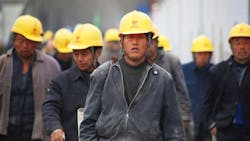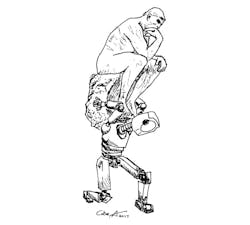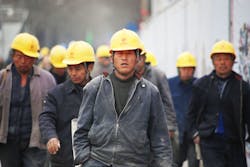Industrial Robot Sales Hit All-Time High…But What About Industry Jobs?
You think robots are pretty cool, don’t you? What if you knew that automated robots were poised to take as many as 97% of industrial jobs over the next decade? Would you still think they were cool?
You’d think they were even cooler then? Well, yeah, you’re probably right. Those would be some pretty sweet robots. But if you want to know how these robots will impact the diminishing industrial job force, read on. And, if you happen to work in the industry, download Uber...because you’re going to need a new job sooner than you can say, “I heart robots for life.”
Industrial robot sales broke a record for the most orders and shipments in 2016, according to The Robotic Industries Association (RIA), but what will this mean for the 1 billion people employed in the manufacturing industry?
It has long been speculated that one day, robots would replace us all. While this may not be exactly what we envisioned in I, Robot, workers in the manufacturing sector are nonetheless feeling the tension. North America and China represent two of the top manufacturing sectors in the world, according to a report issued by the Boston Consulting Group. The Internet of Things (IoT) industry is also booming, and expected to reach $65 billion by 2020—with some 25% of growth dedicated to the industrial sector alone. And every year the sector continues to grow.
Growth
According to the RIA’s 2016 statistics, orders for assembly robotics manufactured in North America increased by 61% in 2016. During that year, 34,606 robots totaling $1.9 billion in sales were ordered from North American robotics manufacturers—a 10% increase in units in just one year. This doesn’t include global robotic sales, although that figure is also expected to grow.
Much of the growth came from the automotive industry, long a supporter of automated technology. The industry saw a 17% increase in orders and a 25% increase in shipments. The food and consumer goods robotic sectors also increased by 32%, and the RIA is expected to see record high numbers at its upcoming robotics conference in April 2017, with 20,000 attendees.
It’s an exciting time for early visionaries of the technologies, roboticists, and enthusiasts alike. The technology of today has certainly come a very long way, but what does this mean for workers in the industry?
Thousands of employees, maybe even millions, are projected to lose their jobs to robots that are not only more efficient, but also more cost-effective than us humans could ever hope to be.
I drew this cartoon with a simple thought in mind: Maybe the robotic workforce that replaces us all will allow humans to do what we do best, to think and create. Wishful thinking, eh? (Courtesy: Cabe Atwell)
Efficiency
Whether we like it or not, using robots to execute repetitive tasks is wildly more efficient than human labor. In one case, the Changying Precision Technology Company replaced 92% of its workforce with automated robots, resulting in a 250% increase in output and an 80% decrease in errors.
Even if quality and output were equal between automated robots and humans (which it is not), robots can save companies gross amounts of money each year on labor alone—one of the most costly business expenses. At the infamous Foxconn factory, automated robots replaced 60% of workers, cutting its labor expenses by more than half. Other companies, including McDonald’s, have considered following suit as a result.
And so on down. The industrial sector is investing heavily in automated robots. More than $430 million in robot investments alone were made in Dongguan, in China’s Guangdong Province. North American robotic manufacturers have seen record high sales, and in all likelihood, this trend will only continue. So, what does this really mean for workers?
Workforce
In the case of The Changying Precision Technology Company, automated robots were able replace an initial 92% of the factory workforce, and will replace an estimated 97% in the near future. If this statistic holds true for other factories who invest in robotics, roughly one billion employees are at risk of losing their jobs.
The manufacturing sector is a relatively large industry. The global workforce includes some 99 million workers in China, 12 million in America, 10 million in Japan, and 19.8 % of the working population in Germany. While the industry is growing, the workforce has already begun to shrink. For example, 2013 marked the first year Japan’s manufacturing workforce fell below 10 million in 50 years. In the United States, the manufacturing workforce is expected to fall to 11,374 people by 2024.
But, when we really think about it, is this so bad?
The Controversy
Only if we forget all about the conditions most manufacturing laborers have to endure. Remember Foxconn? Sixteen of its employees committed suicide between 2012, with another 300 who threatened to do so in response to a compensation issue at the Foxconn factory that makes Xbox consoles. The company also has had several riots involving up to 2,000 people at the factories that make iPhones – where employees work 60 hours a week, every week. Add that together with all of the terrible working conditions in sweatshops and instances of forced labor (remember guys, that thing called slavery?), and we must ask ourselves if this is really all that bad of a deal?
In Retrospect
Isn’t it a good thing if people don’t have to spend 60 hours a week putting thousands of stickers on an iPhone? It seems many people forget that the industrial revolution enhanced productivity so companies could increase productivity, not so human beings could lead more fulfilling lives. Maybe out of a billion people who currently work life-sucking day jobs, half get hired by Comcast to work at call centers, some go back to school to learn some kind of skilled trade, and some get sick of working for someone else and start their own businesses —because, to hell with the system!
Of the workers who are employed in the manufacturing sector, not all of these people will lose their jobs. Some will transition to operational roles, some will provide technical support for the robotic machines, and others will learn a skilled trade that will enable them to fill the vastly undersupplied workforce in STEM fields. Or, as history shows us: The workforce will transition to the service sector.
Future Projections
One of the trendiest service sectors now is coffee-related businesses. The coffee industry has already grown dramatically in China, and the American coffee industry is expected to hit $46.2 billion by 2021. That’s just coffee.
With this, those who don’t pick up an espresso machine or server job can also start their own niche businesses within the service industry—a trend that’s already started. According to new statistics released by Pew, 30% of jobs are filled by self-employed people or directly provided by self-employed persons. Sites like Etsy have had tremendous growth in recent years. Even if many of the vendors on the site aren’t able to support themselves solely from sales, there are tons of ways to create supplemental income in today’s digital world.
If all else fails, we may move closer to a world where the basic human standard of living is subsidized by the government. According to Elon Musk, as technology improves, there simply will not be enough jobs to go around. He predicts the government will have to subsidize basic human living expenses. The idea was already talked about in Sweden and mentioned by former President Barack Obama.
It’s very possible the future workforce will be comprised of a patchwork of niche entrepreneurs, artisans, scientists, doctors, and sustenance agriculturalists. If you work in the industrial sector, grab a tractor and a hoe: It’s going to be a bumpy century.
About the Author
Cabe Atwell
Engineer, Machinist, Maker, Writer. A graduate Electrical Engineer actively plying his expertise in the industry and at his company, Gunhead. When not designing/building, he creates a steady torrent of projects and content in the media world. Many of his projects and articles are online at element14 & SolidSmack, industry-focused work at EETimes & EDN, and offbeat articles at Make Magazine. Currently, you can find him hosting webinars and contributing to Penton’s Electronic Design and Machine Design.




